How to Propagate Prickly Pear Cactus: A Guide for Beginners
Prickly pear cactus is a popular plant that is known for its unique appearance and delicious fruit. Propagating prickly pear cactus is a great way to expand your collection or share the plant with others. With the right tools and techniques, propagating prickly pear cactus can be a fun and rewarding experience.
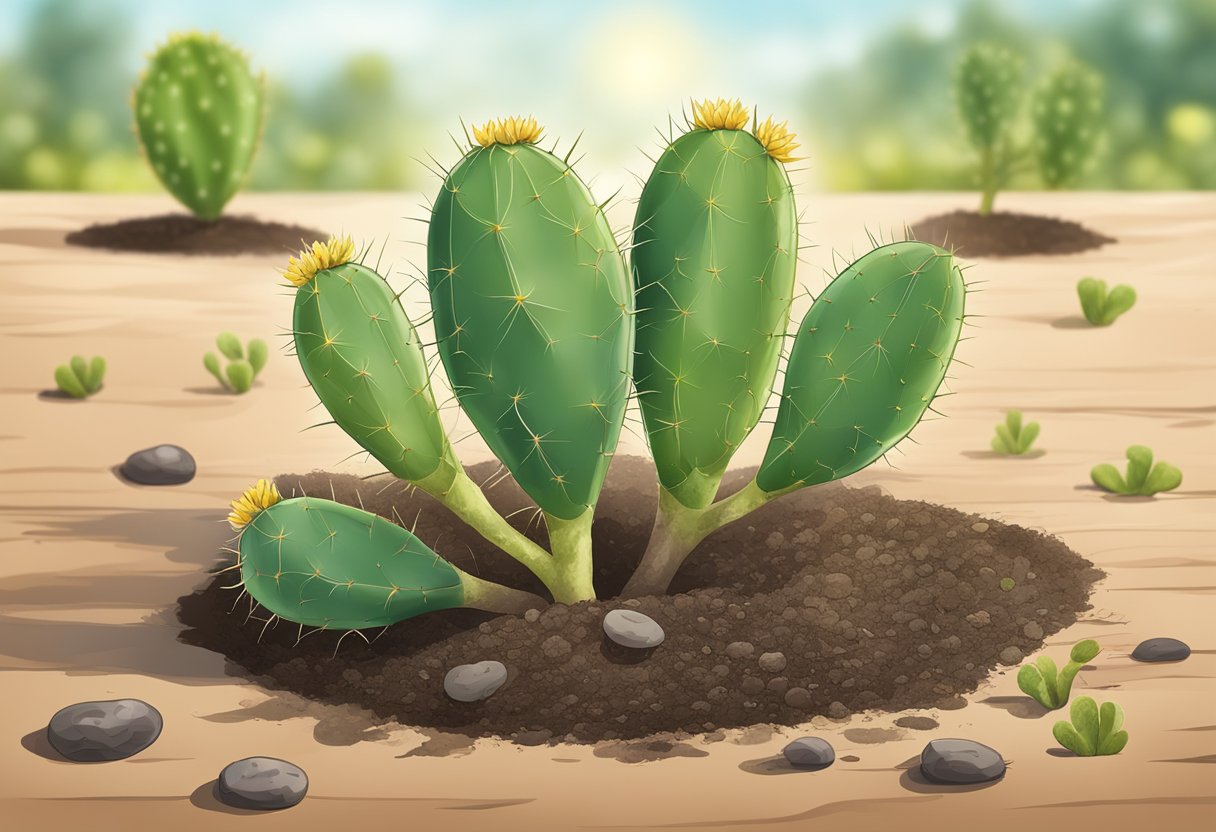
To propagate prickly pear cactus, it is important to first understand the plant’s natural growth habits. Prickly pear cactus typically grows from pads, which can be cut and replanted to create new plants. The pads should be allowed to dry for a few days before planting to prevent rotting. Additionally, prickly pear cactus can also be propagated from seeds, although this method can be more challenging and time-consuming.
In this article, we will explore the best methods for propagating prickly pear cactus, including how to prepare the pads for planting, how to care for new plants, and tips for maintaining a healthy and thriving cactus garden. Whether you are a seasoned cactus enthusiast or just starting out, this guide will provide you with the knowledge and confidence you need to successfully propagate prickly pear cactus.
Understanding Prickly Pear Cactus
Species Overview
Prickly pear cactus, also known as Opuntia, is a genus of cacti that belongs to the family Cactaceae. There are over 200 species of prickly pear cactus, and they are native to the Americas. The cactus is known for its flat, paddle-shaped leaves that are covered in spines, hence the name “prickly pear.”
Prickly pear cactus is a popular plant for landscaping and gardening due to its unique appearance and low maintenance requirements. The cactus produces vibrant flowers in shades of yellow, orange, and red, which bloom in the spring and summer months.
Growth Characteristics
Prickly pear cactus is a succulent plant, which means it stores water in its leaves and stem. The cactus is well adapted to arid climates and can survive in hot, dry environments. The plant can grow up to 20 feet tall in the wild, but in cultivation, it typically reaches a height of 3-6 feet.
Prickly pear cactus is a slow-growing plant, and it can take several years for the cactus to reach maturity. The plant prefers well-draining soil and full sun exposure. Prickly pear cactus can also tolerate partial shade, but it may not produce as many flowers.
The cactus is easy to propagate, and it can be grown from seeds, cuttings, or offsets. Propagation by cuttings is the most common method, and it involves taking a section of the stem and allowing it to dry for a few days before planting it in well-draining soil.
Overall, prickly pear cactus is a unique and fascinating plant that is easy to grow and maintain. It is a great addition to any garden or landscape, and it is sure to impress with its striking appearance and vibrant flowers.
Propagation Basics
Propagation Methods
Prickly pear cactus can be propagated through several methods such as cuttings, seeds, and division. Cuttings are the most common method of propagation and involve removing a section of the cactus pad and allowing it to dry for a few days before planting. Seeds can also be used, but they take longer to grow and may not produce the same characteristics as the parent plant. Division involves separating a clump of pads from the parent plant and planting them separately.
Best Time to Propagate
The best time to propagate prickly pear cactus is in the spring or fall when the plant is actively growing. During these seasons, the cactus is better equipped to handle the stress of propagation and is more likely to produce healthy new growth. It is important to avoid propagating during the summer when the cactus is dormant and more susceptible to damage.
When propagating through cuttings, it is important to choose healthy pads that are free from disease and pests. The pads should be allowed to dry for a few days before planting to prevent rotting. When planting, the pads should be placed in a well-draining soil mix and watered sparingly until new growth appears.
When propagating through seeds, it is important to use fresh seeds and to plant them in a well-draining soil mix. The seeds should be watered regularly and kept in a warm, sunny location until they germinate.
When propagating through division, it is important to use a clean, sharp knife to separate the clump of pads. The pads should be allowed to dry for a few days before planting, and care should be taken to avoid damaging the roots. When planting, the pads should be placed in a well-draining soil mix and watered sparingly until new growth appears.
Overall, propagating prickly pear cactus can be a rewarding experience and is a great way to expand your collection of these unique and beautiful plants. By following these basic propagation methods and timing your propagation correctly, you can successfully grow healthy new plants from your existing prickly pear cactus.
Preparing for Propagation
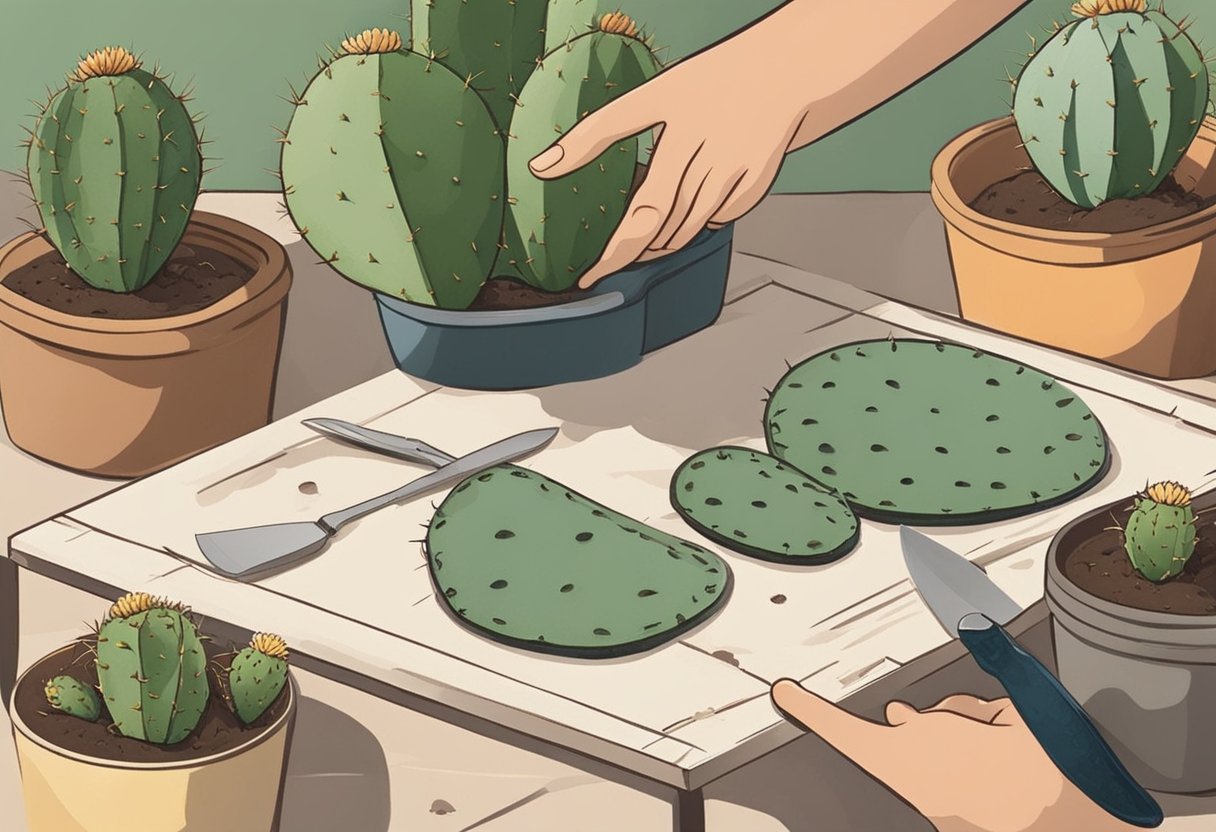
Propagating prickly pear cactus can be a fun and rewarding experience for any gardener. However, it is important to properly prepare for propagation to ensure the best possible results. This section will cover the necessary steps to prepare for propagation, including selecting quality cuttings, cutting and callusing, and soil and container preparation.
Selecting Quality Cuttings
The first step in preparing for propagation is to select quality cuttings. It is important to choose healthy, mature pads that are free from damage or disease. The pads should be firm to the touch and have a good color. It is also important to choose pads that are at least six months old, as younger pads may not have developed enough to successfully propagate.
Cutting and Callusing
Once quality cuttings have been selected, the next step is to cut and callus them. Cuttings should be taken using a sharp, clean knife or pruning shears. The cuttings should be at least six inches long and should be taken from the top of the pad. After cutting, the cuttings should be left to callus for several days in a warm, dry location. This will allow a callus to form over the cut end, which will help prevent rot during planting.
Soil and Container Preparation
The final step in preparing for propagation is to prepare the soil and containers. Prickly pear cactus requires well-draining soil, so it is important to choose a soil mix that is specifically designed for cactus and succulents. A mixture of sand, perlite, and cactus soil or succulent mix can be used to create a well-draining soil. Containers should also have good drainage to prevent water from accumulating and causing rot.
In summary, preparing for propagation of prickly pear cactus requires selecting quality cuttings, cutting and callusing, and soil and container preparation. By following these steps, gardeners can ensure the best possible results when propagating their prickly pear cactus.
Planting and Initial Care
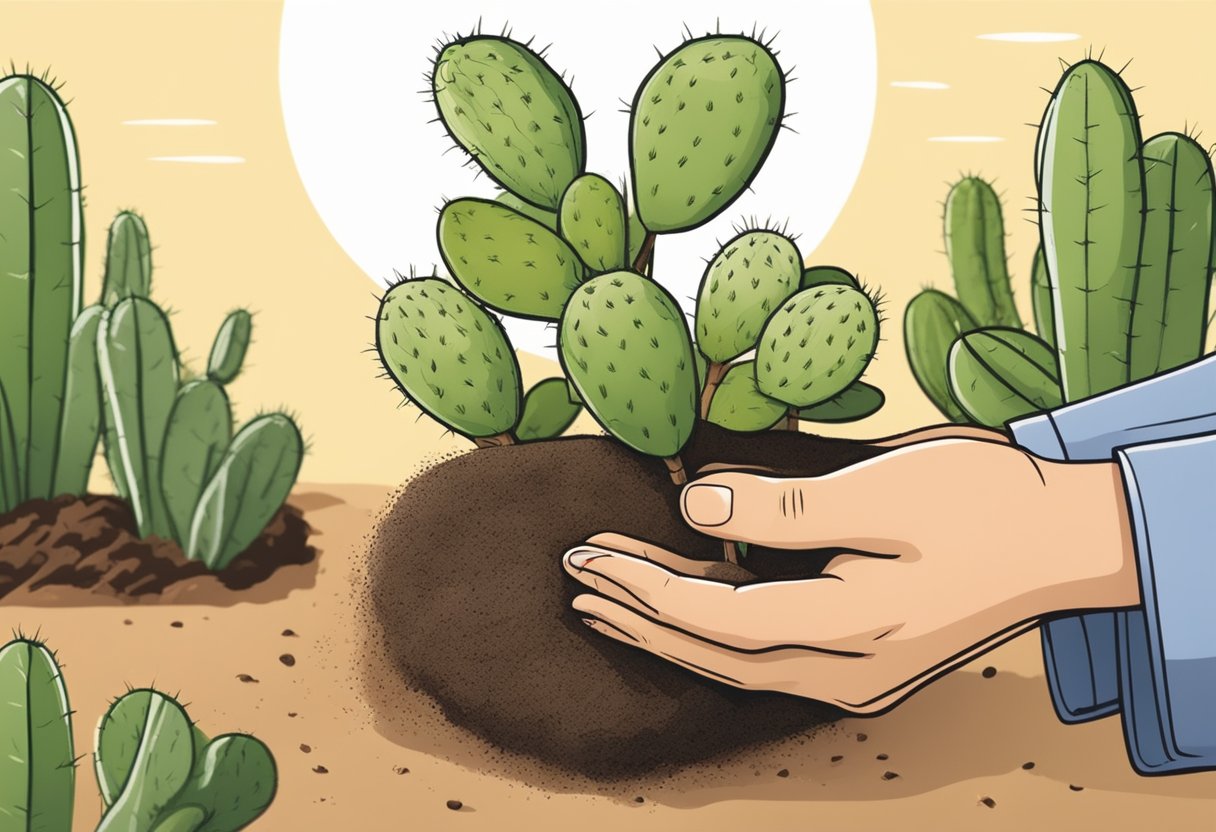
Planting Cuttings
When propagating prickly pear cactus, planting cuttings is a common method. The first step is to select healthy cuttings from the parent plant. Look for segments that are at least 6 inches long and have no signs of damage or disease. Let the cuttings dry out for a few days before planting to allow the wound to callus over.
Once the cuttings have callused, they are ready to be planted. Use a well-draining soil mix and plant the cuttings about 1-2 inches deep. It’s important to avoid watering the cuttings for the first two weeks to prevent rot. After two weeks, you can begin to water the cuttings sparingly.
Watering and Temperature
Prickly pear cactus prefers well-draining soil and does not like to be overwatered. It’s important to let the soil dry out completely between waterings. The frequency of watering will depend on the temperature and humidity of your environment. In general, cactus plants prefer temperatures between 60-80°F (15-27°C).
Sunlight and Placement
Prickly pear cactus thrives in bright light, but it’s important to avoid direct sunlight during the hottest part of the day. If you live in a hot climate, consider placing the cactus in filtered sunlight or providing shade during the hottest part of the day. When choosing a location for your prickly pear cactus, make sure it has enough space to grow and won’t be disturbed by foot traffic or pets.
With proper planting and initial care, your prickly pear cactus should begin to root and grow within a few weeks. Remember to be patient and avoid overwatering or exposing the cactus to extreme temperatures or direct sunlight.
Monitoring and Maintaining Growth
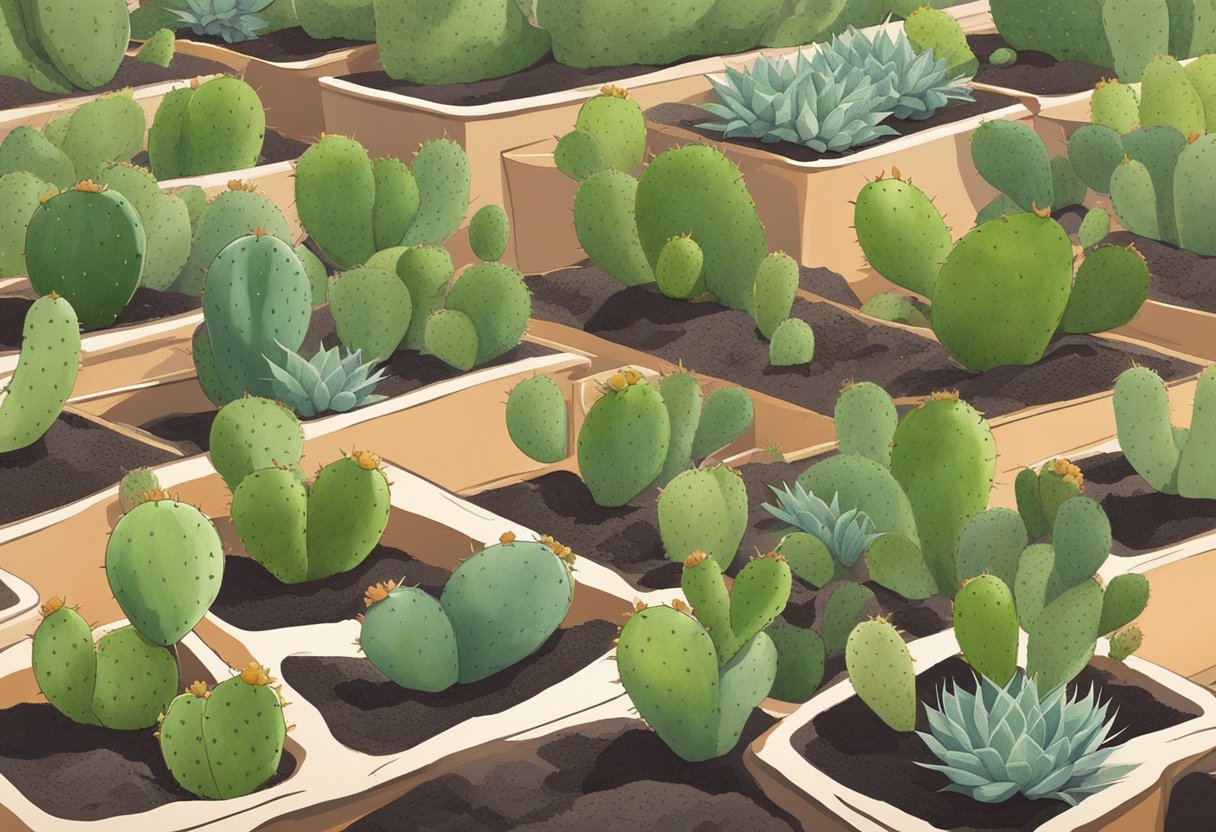
Observing New Growth
Once the prickly pear cactus has been propagated successfully, it is important to monitor its growth regularly. This will help the gardener to identify any issues early on and address them before they become more severe. One of the first signs of new growth is the appearance of small buds on the cactus pads. These buds will eventually develop into new pads, which will increase the overall size of the plant.
Managing Pests and Diseases
Prickly pear cacti are generally hardy plants, but they can be susceptible to certain pests and diseases. Scale insects and mealybugs are common pests that can infest the cactus, causing damage to the plant. These pests can be managed by regularly inspecting the plant and removing any visible insects. In severe cases, an insecticidal soap can be used to control the infestation.
Another potential issue that can arise with prickly pear cacti is root rot. This can occur if the plant is overwatered or if it is planted in soil that does not drain well. To prevent root rot, it is important to plant the cactus in a well-draining cactus mix and to avoid overwatering.
Transplanting Mature Plants
As the prickly pear cactus grows, it may eventually outgrow its container. When this happens, it may be necessary to transplant the cactus into a larger container or into the garden. When transplanting a mature plant, it is important to be careful not to damage the roots. The plant should be watered thoroughly a few days before transplanting to make it easier to remove from the container.
Once the plant has been removed from the container, it should be inspected for any signs of root damage or disease. If any issues are identified, they should be addressed before the plant is transplanted. The new container or planting hole should be prepared with well-draining soil, and the cactus should be planted at the same depth as it was in its previous container. After transplanting, the cactus should be watered thoroughly and placed in a location with plenty of sunlight to encourage healthy growth.
Advanced Propagation Techniques

Using Rooting Hormones
Rooting hormones are a great way to promote root growth in prickly pear cactus cuttings. Rooting hormone powder is readily available in most garden centers and can be found in different strengths. When using rooting hormone, it is important to follow the manufacturer’s instructions carefully.
To apply rooting hormone, simply dip the cut end of the cactus cutting into the rooting hormone powder, making sure to coat the entire cut surface. Then, plant the cutting in well-draining soil and water it thoroughly.
Using rooting hormone can significantly increase the success rate of cactus propagation. However, it is important to note that rooting hormone is not necessary for successful propagation, and some gardeners prefer to propagate their cactus cuttings without it.
Seed Propagation Challenges
While prickly pear cactus can be propagated from seeds, there are some challenges to seed propagation that should be considered.
One challenge is the germination rate of prickly pear cactus seeds. These seeds have a relatively low germination rate, and it can take several weeks or even months for them to germinate.
Another challenge is the need for proper soil and moisture conditions for successful seed germination. Prickly pear cactus seeds require well-draining soil and consistent moisture to germinate.
Despite these challenges, seed propagation can be a rewarding way to propagate prickly pear cactus. It is important to be patient and provide the right growing conditions for the seeds to germinate and grow.
In conclusion, using rooting hormone and seed propagation are two advanced techniques for propagating prickly pear cactus. While they both have their challenges, they can be effective ways to propagate this unique and beautiful plant.
Caring for Established Prickly Pears

Once your prickly pear cactus has established itself, it requires minimal care. However, there are a few things to keep in mind to ensure that it continues to thrive.
Ongoing Care and Tips
Prickly pears are drought-tolerant plants and can survive with minimal watering. In fact, overwatering can be harmful to the plant and may cause root rot. It is best to water the plant deeply but infrequently, allowing the soil to dry out between waterings.
During the growing season, it is recommended to fertilize the plant every four to six weeks with a balanced fertilizer. Be sure to follow the instructions on the fertilizer package and avoid over-fertilizing.
Prickly pears are also prone to pests such as mealybugs and scale insects. Regularly inspect the plant for any signs of infestation and treat it promptly if necessary.
Harvesting Fruit and Pads
Prickly pear cacti produce edible fruit, known as tunas, and pads, which can be cooked and eaten. The fruit is ripe when it is soft to the touch and the skin is a deep red or purple color. Use gloves or tongs when harvesting tunas as they have spiny fruits.
To harvest pads, wait until they are about six inches long and use a sharp knife to cut them from the plant. Be sure to leave a small portion of the pad attached to the plant to ensure that it continues to grow.
In summary, caring for established prickly pear cacti is relatively easy. Provide minimal watering, fertilize regularly, and watch for pests. When harvesting fruit and pads, use gloves or tongs and be careful not to damage the plant.
Landscape and Decorative Uses

Outdoor Landscaping
Prickly pear cactus is a popular choice for outdoor landscaping due to its ability to thrive in hot and arid climates. Its unique appearance and low maintenance requirements make it a great addition to any garden or landscape design. Prickly pear cactus can be used to create a southwestern flair in gardens and landscapes.
One of the advantages of using prickly pear cactus in landscaping is that it can grow in a variety of soil types, including sandy and rocky soils. It also tolerates drought and requires minimal watering, making it a great choice for water-wise landscaping.
Indoor and Container Gardening
Prickly pear cactus can also be grown indoors and in containers. When grown indoors, it can add a touch of southwestern flair to any room. It is also a great option for those who want to add succulents to their houseplants collection.
When grown in containers, prickly pear cactus can be used to create a unique focal point in any outdoor space. It is important to choose a container that is large enough to accommodate the cactus and provides good drainage. Prickly pear cactus can also be grown in shaded areas, making it a versatile option for container gardening.
Nurseries often carry a variety of prickly pear cactus species, including Opuntia microdasys, which is known for its fuzzy appearance. When selecting a prickly pear cactus, it is important to choose a healthy plant with no signs of damage or disease.
Overall, prickly pear cactus is a versatile and low maintenance option for both outdoor and indoor landscaping. Its unique appearance and ability to thrive in harsh conditions make it a great addition to any garden or container garden.
Troubleshooting Common Issues
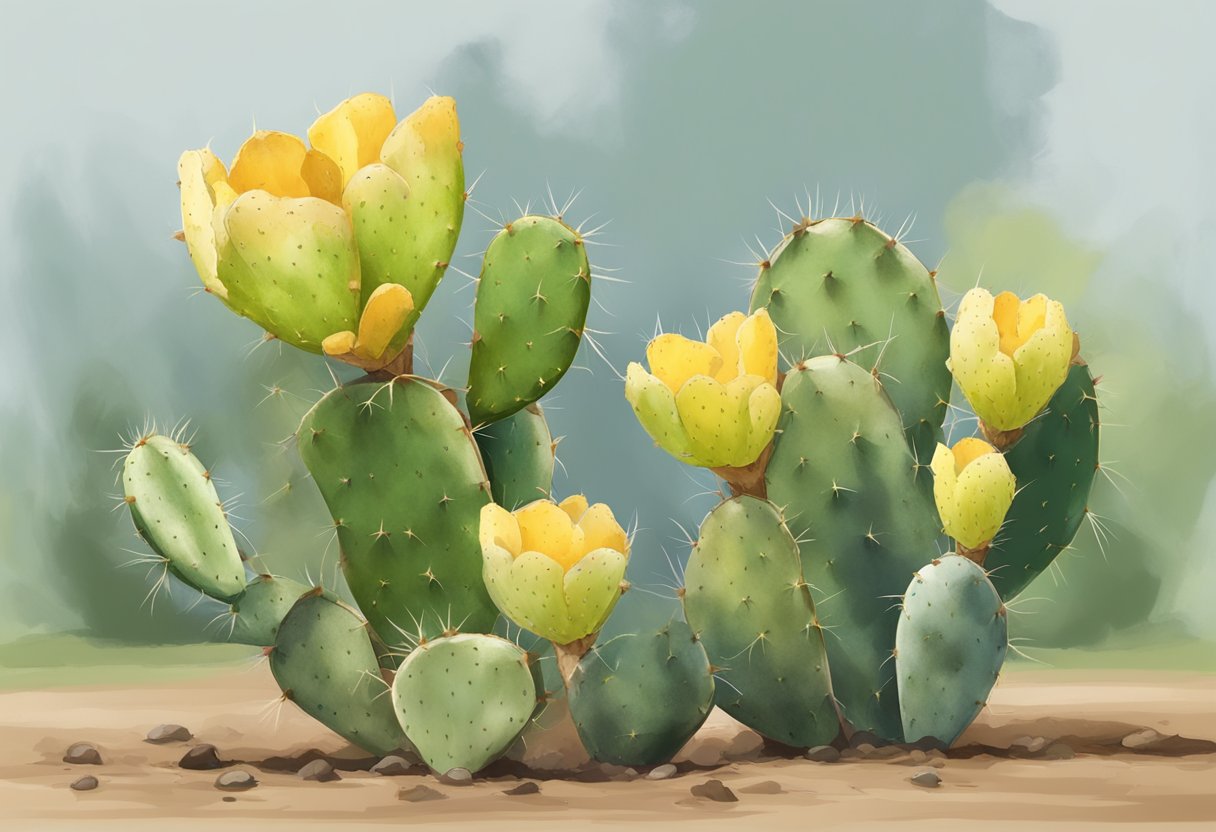
Dealing with Poor Growth
If your prickly pear cactus is experiencing poor growth, there are a few things you can do to address the issue. First, make sure the cactus is getting enough sunlight. Prickly pear cacti require full sun exposure to thrive. If the cactus is not getting enough sunlight, consider moving it to a sunnier location.
Another possible cause of poor growth is soil quality. Prickly pear cacti prefer well-draining soil with a pH between 6.0 and 7.5. If the soil is too compacted or has poor drainage, the cactus may not be able to absorb enough nutrients. Consider repotting the cactus in a soil mix specifically designed for cacti and succulents.
Addressing Overwatering and Underwatering
Overwatering and underwatering are common issues that can affect prickly pear cacti. Overwatering can lead to root rot, while underwatering can cause the cactus to dry out and die.
To address overwatering, reduce the frequency of watering and make sure the soil has adequate drainage. If the cactus is already showing signs of root rot, remove it from the soil and cut away any affected roots. Repot the cactus in fresh soil and allow it to dry out completely before watering again.
To address underwatering, increase the frequency of watering and make sure the soil is thoroughly soaked each time. However, be careful not to overwater the cactus, as this can lead to other issues.
Established roots can also contribute to the health of the prickly pear cactus. Once the roots are established, the cactus becomes more low-maintenance. However, it is important to continue monitoring the cactus for any signs of issues, such as poor growth or overwatering.
Frequently Asked Questions
What are the steps to propagate a prickly pear cactus from a pad?
To propagate a prickly pear cactus from a pad, the first step is to choose a healthy pad from a mature cactus. The pad should be cut from the cactus using a clean, sharp knife. After cutting the pad, it should be left to dry for a few days until the cut end has formed a callus. Once the pad has callused, it can be planted in well-draining soil and watered sparingly until roots and new growth appear.
Can you grow a prickly pear cactus from seeds, and if so, how?
Yes, prickly pear cactus can be grown from seeds. The seeds should be collected from ripe fruit and planted in well-draining soil. They should be watered regularly until they germinate and new growth appears. It is important to note that growing prickly pear cactus from seeds can be a slow process and may take several years to reach maturity.
What is the best method to propagate a spineless prickly pear cactus?
The best method to propagate a spineless prickly pear cactus is by using cuttings. Cuttings should be taken from a mature cactus using a clean, sharp knife. After cutting, the cutting should be left to dry for a few days until the cut end has formed a callus. Once the cutting has callused, it can be planted in well-draining soil and watered sparingly until roots and new growth appear.
How do you care for a prickly pear cactus during its growth stages?
During its growth stages, prickly pear cactus should be watered sparingly and planted in well-draining soil. It should be placed in a location with plenty of sunlight and protected from extreme temperatures. Prickly pear cactus does not require fertilization, but a balanced fertilizer can be applied sparingly during its growing season.
Is it possible to propagate a prickly pear cactus in water, and how?
Yes, prickly pear cactus can be propagated in water. Cuttings should be taken from a mature cactus using a clean, sharp knife. After cutting, the cutting should be left to dry for a few days until the cut end has formed a callus. Once the cutting has callused, it can be placed in a container with water, making sure that the bottom of the cutting is submerged. The water should be changed regularly, and roots will begin to appear after a few weeks. Once roots have formed, the cutting can be planted in well-draining soil.
What are the ideal conditions for growing a prickly pear cactus indoors?
Prickly pear cactus can be grown indoors, but it requires plenty of sunlight. It should be placed near a window with southern exposure and protected from extreme temperatures. It should be planted in well-draining soil and watered sparingly. It is important to note that prickly pear cactus can grow quite large, so it may not be suitable for small indoor spaces.
